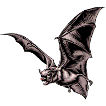Museum, University of Nebraska State

University of Nebraska State Museum: Mammalogy Papers
Document Type
Article
Date of this Version
1978
Citation
Academy of Natural Sciences of Philadelphia, Special Publication (1978) 13: 53-97.
Abstract
Analysis of the bat fauna of the Antillean Islands suggest that the most probable source of invasion of the islands by bats is by overwater dispersal. The bat fauna of ·the Greater Antilles is unique, a percentage of endemism on each island being over 50 percent except for the Virgin Islands which has 33 percent endemics.
The richest bat fauna in the Antilles is on Cuba (32 species) followed by Jamaica (23 species) then Hispaniola (17 species) and Puerto Rico (16 species). The number of species found on Cuba is probably the result of the island's proximity to Central and North America and the ecological complexity of the island. Jamaica has a rich fauna because of its proximity to Central America and Cuba. The reduced fauna of Hispaniola (relative to Jamaica and Cuba) is probably because species have nor reached this island with the frequency that they have reached Jamaica and Cuba (Hispaniola is as close to Cuba as is Jamaica). Puerto Rico (smaller than Cuba, Hispaniola, and Jamaica) has even a more remote position relative to the mainland and the poorest fauna of the four largest islands. Mainland species that are found on Puerto Rico and Hispaniola are also found on Jamaica and Cuba. Only two Puerto Rican species (BrachyphylIa cavernarnum and a sub-Recent fossil, Monophyllus plethodon) have their primary distribution in the Lesser Antilles and both of these species have counterparts in the other Greater Antillean islands.
The Bahamas are zoogeographically Antillean in nature with nine out of ten species recorded from the Bahamas being found on Cuba; the tenth is a species of Natalus found only in the Bahamas, which has its closest relatives in the Greater Antilles. The Bahaman bat fauna shows less affinity to the bat fauna of the southern half of Florida; two of the ten extant species but neither of the two Pleistocene fossil species from southern Florida are found in the Bahamas. The percentage of endemism of the Bahaman fauna (60 percent) is also in accordance with that characteristic of the Greater Antilles.
Whereas the Greater Antilles represent a chiropteran fauna that involves multiple invasions and subsequent radiations, the Lesser Antilles represent fewer invasions and subsequent speciation has not occurred with the frequency found in the Greater Antilles. In the Lesser Antilles only Myotis is represented by more than a single endemic species and the specific distinctness of these two taxa is open to question (it is possible that both are conspecific with mainland M. nigricans or that both represent a single endemic species). Most of the evolutionary activity of the Lesser Antillean bat faunas has been associated with Guadeloupe. The Lesser Antilles have served as an effective filter barrier and tbe faunas of individual islands reflect their relative position in the chain. Although Grenada and possibly the Grenadines are in the Antillean chain, they represent a reduced mainland fauna with no Antillean endemic species. Zoogeographically. Grenada and the Grenadines are mainland islands.
From a zoogeographic and evolutionary standpoint most of the action in the Caribbean has occurred in the Greater Antilles. The bat fauna of the Greater Antilles appears to indicate that the Greater Antillean chiropteran fauna is unique, as was suggested by Simpson (1956) based upon land mammals and, as such, represents a distinctive faunal region. On the other hand. the fauna of the Lesser Antilles is less distinctive and primarily represents a depauperate attenuation of the Neotropical fauna of South America.
Included in
Biodiversity Commons, Other Ecology and Evolutionary Biology Commons, Population Biology Commons, Terrestrial and Aquatic Ecology Commons, Zoology Commons


Comments
Copyright 1978, Academy of Natural Sciences of Philadelphia. Used by permission.